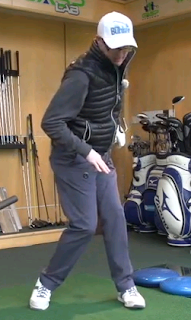Hip Sway, Weight Shift, & Impact Position:
Sliding your hips laterally on the backswing causes the weight shift on the downswing to have to be much more brutal. This usually forces the golfer to come across the ball "over the top" otherwise you will hit way behind the ball.
The hip sway can usually be traced back to the setup. If you have your right foot splayed out to the right (so not perpendicular to target line) or do not have your right knee kicked slightly at address, you can easily sway (see setup section). This fault causes many people to try to push their hands out on the target line to try to stop the ball starting left. From this action all sorts of shots can occur resulting in major inconsistency and a loss of distance.
Touring professional Robert Karlson on left demonstrating proper coil around inside of right leg (notice his right hip stays inside the red line that was drawn at address). Amateur on right demonstrating the hip slide (notice that his right hip has moved beyond the red line that was drawn at address). By getting the order wrong on the way back, it makes the proper unwinding and impact position on the downswing fairly impossible.
A common thought to generate power has been the idea of weight transfer, and this thought has undoubtedly caused the hip slide/ sway in many amateur swings (see Stack and Tilt Golf Swing & Weight Shift). However as you look at Tiger Woods here, notice that there isn't a 100% weight shift on the backswing to a 100% weight shift on the downswing. He is turning around his axis point (see Sean Foley below), notice that his right hip has stayed inside his foot's right instep on the backswing. Notice how he doesn't slide to his right on the backswing, instead he compresses into the ground ("the squat") and then compresses into the ground even more at the start of the downswing, before then beginning to add side bend in his left hip when coming into impact. Notice at impact leg is straightening, a key point that shows he has not slid towards the target. He is in balance and control of his lower body throughout the entire swing.
The correct weight shift and impact position should include side bend where your right hip and shoulder is lower than your left hip and shoulder (it should feel as if your left pocket is higher than your right pocket). Incorrect weight shift and impact position caused by the sway creates no side bend at impact where you swing over the top creating a slice shot.
A common thought to generate power has been the idea of weight transfer, and this thought has undoubtedly caused the hip slide/ sway in many amateur swings (see Stack and Tilt Golf Swing & Weight Shift). However as you look at Tiger Woods here, notice that there isn't a 100% weight shift on the backswing to a 100% weight shift on the downswing. He is turning around his axis point (see Sean Foley below), notice that his right hip has stayed inside his foot's right instep on the backswing. Notice how he doesn't slide to his right on the backswing, instead he compresses into the ground ("the squat") and then compresses into the ground even more at the start of the downswing, before then beginning to add side bend in his left hip when coming into impact. Notice at impact leg is straightening, a key point that shows he has not slid towards the target. He is in balance and control of his lower body throughout the entire swing.
The correct weight shift and impact position should include side bend where your right hip and shoulder is lower than your left hip and shoulder (it should feel as if your left pocket is higher than your right pocket). Incorrect weight shift and impact position caused by the sway creates no side bend at impact where you swing over the top creating a slice shot.
This hip slide on the downswing is not what you want. This fault will result in big pushes and other shots that will lead to inconsistency. See the drills below
Drill 1:
Drill 1:
Have your right foot back and up on it's toe. Make a swing staying in balance. Your right foot in this position will not let you over-rotate or hip sway without falling over/ losing your balance.
Drill 2:
Drill 4:
Put a balance disc under your right leg (for right handed golfers) to make sure you keep your knee flexed on the backswing and also to make sure you don't over-rotate or have a negative spine angle.
Drill 2:
Where impact is not dynamic:
no opening up of hips and shoulders and little weight shift to left side, there
is a loss of distance and consistency of strikes. See drill (pictured right)
Drill: start at address
position, pick your hands up an inch and put them towards the target two (so
should be slightly steeper shaft plane and a slight forward press), then turn
onto your left leg.
Drill 3:
This drill involves posting on
your left leg by throwing a ball straight between two clubs/ sticks. This gives the proper impact position, posting on your left leg.
Drill 4:
Put a balance disc under your right leg (for right handed golfers) to make sure you keep your knee flexed on the backswing and also to make sure you don't over-rotate or have a negative spine angle.

















No comments:
Post a Comment